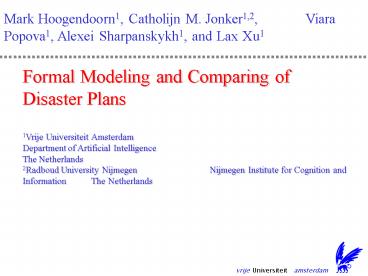CIM PowerPoint PPT Presentation
1 / 16
Title: CIM
1
Mark Hoogendoorn1, Catholijn M. Jonker1,2,
Viara Popova1, Alexei Sharpanskykh1, and Lax
Xu1
Formal Modeling and Comparing of Disaster
Plans 1Vrije Universiteit AmsterdamDepartment
of Artificial IntelligenceThe Netherlands 2Radbou
d University Nijmegen
Nijmegen Institute for Cognition and
Information The Netherlands
2
Contents
- Introduction to Disaster Plans
- Formal Description of Disaster Plans
- Steps in formalizing disaster plans
- Organizational Structure
- Tasks and Responsibilities
- Organizational Change
- Case Study Uithoorn vs. Eindhoven
- Conclusions
3
Introduction to Disaster Plans (1)
- Describes the relation between different
organizations that might be involved in disaster
prevention. - Specified in general terms, more detailed are
the disaster prevention plans, describing a
particular object. - NL By law every municipality required to have a
disaster plan. - Disaster plans differ per municipality due to
- Available resources
- Infrastructure
- High-risk objects
4
Introduction to Disaster Plans (2)
- NL Disaster plans are not developed from a
common template. - Some municipalities use a common starting point.
- Others start from scratch.
- Municipalities test the compatibility of
disaster plans by organization exercises, there
are however several disadvantages - No incident is ever the same.
- Conditions differ (stress situations)
5
Formal Description of Disaster Plans
- Proposed approach Formal specification of
disaster plans. - Advantages
- Formalization process raises questions with
respect to intended meaning and possible
consequences. - Grouping comparable parts of two disaster plans
brings to light differences. - Logical proof theory can be used.
6
Steps in Formalizing Disaster Plans
- Phase identification Which phases are
distinguished and are covered by the disaster
plan? - For each phase within the disaster plan
- Organizational Structure
- Identify roles (e.g. fire department)
- Identify communication links between these roles
- Tasks and responsibilities What are the tasks
and responsibilities for the roles that have been
identified? - Organizational Change What are the conditions
for organizational change (i.e. up-and
downscaling)? What are the exact changes?
7
Organizational Structure
- Formal modeling approach from v.d. Broek et al.
2005 is used. - An organizational structure consists of the
following elements
Roles
- Interaction Link
- Interlevel Link
Fire Dept.
Police
Level 0
Level 1
Commander
Commander
Fire Fighter
Policeman
8
Tasks and Responsibilities
- Formal language has been created for this
purpose. - The following SORTS are used TASK, PHASE, ROLE,
and ORGANIZATION. - Relationships are defined
- is_subtask_of(TASK x TASK)
- executes_task_primary(ROLE x TASK)
- executes_task_secondary(ROLE x TASK)
- coordinates_task_primary(ROLE x TASK)
- coordinates_task_secondary(ROLE x TASK)
- operational_leadership_in(ROLE x ROLE)
9
Organizational Change
- Approach adopted from Hoogendoorn et al.,
2004, extended with triggers for change. - Language and approach allows for expressing
change within an organization - add(ORG_ELEMENT) ? ORG_CHANGE_ELEMENT
- delete(ORG_ELEMENT) ? ORG_CHANGE_ELEMENT
- modify(ORG_ELEMENT x ORG_ELEMENT) ?
ORG_CHANGE_ELEMENT - In addition, the following relation is present
- is_trigger_for(TRIGGER x PHASE x
ORG_CHANGE_ELEMENT)
10
Case Study (1)
- Took two disaster plans
- Eindhoven
- ? 200,000 residents
- Many industrial areas (e.g. Philips electronics)
- Military airport (Hercules disaster 1996)
- Uithoorn
- ? 30,000 residents
- Based on common template with Amsterdam
- Large chemical factory exploded in 1992
11
Case Study (2)
- Analysis and Comparison of Disaster plans
- Two types of properties can be analyzed
- Local municipality properties Does not
influence neighboring municipalities. - Regional coordination properties Do influence
neighboring municipalities and have to be the
same. - When properties differ, formal proof theory has
been used to analyze these differences.
12
Case Study (3)
- Properties that have been verified
- The mayor of the biggest municipality
coordinates the managing platform in the
incident management organization of Municipality
X in phase 4 - state(?, PHASE4) coordinates_task_primary(bigg
est_mun_mayor, MPC) ? disaster_plan(x) - Property holds for XUithoorn and does not for
XEindhoven - The mayor of the municipality first involved in
the incident coordinates the managing platform
in the incident management organization of
Municipality X in phase 4 - state(?, PHASE4) coordinates_task_primary(mayo
r_first_involved, MPC) ? disaster_plan(x) - Property holds for XEindhoven and does not for
XUithoorn
13
Case Study (4)
- The command centre of surroundings of the
disaster area (ComRT) is part of the incident
management organization of Municipality X in
phase 4 - state(?, PHASE4) is_role_in(ComRT, ORG4) ?
disaster_plan(x) ? is_organization_in_phase(ORG4,
PHASE4) - Property holds for X Uithoorn and does not
hold for XEindhoven - Want to prove the following (P1)
- The set of tasks assigned to CoRT in the
disaster plan of Eindhoven is the same as the
set of tasks assigned to the CoRT and ComRT in
the disaster plan of Uithoorn
14
Case Study (5)
- Proof tree
- P2 (informal) All tasks of CoRT in the disaster
plan of Eindhoven are tasks of CoRT or ComRT in
the disaster plan of Uithoorn - P3 (informal) All tasks of CoRT and ComRT in the
disaster plan of Uithoorn are tasks of CoRT in
the disaster plan of Eindhoven
P1
P2
P3
P4
P5
15
Conclusions
- Framework for formal modeling and comparing
disaster plans has been introduced. - Using these kind of formalisms enables automated
checking (for which an environment has already
been developed). - Application in case-studies provided useful
results. - Can be incorporated in systems such as IMI, when
a disaster plan is added to the system it can be
formally proven to be consistent with the plans
already in the database. - Future Work Development of tools that support
the formalization process.
16
Questions?

